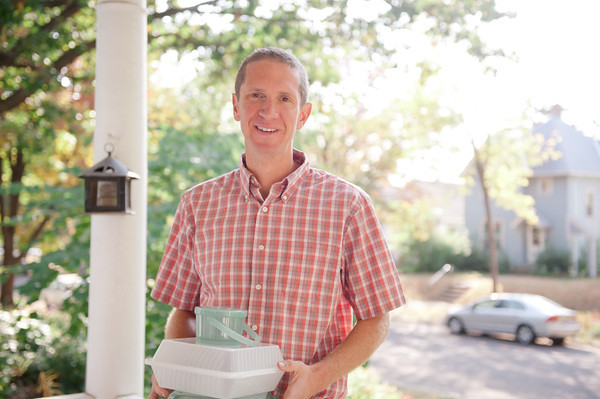
If you eat takeout food, chances are good there’s a motley collection of plastic to-go containers stacked in rickety towers and sloping piles of lids in some low drawer or cupboard of your kitchen. Some are sturdy and useful, and you’ll keep them until they are too warped to use or the lid goes on walkabout, but eventually they’ll all end up in the waste stream — alongside the millions of Styrofoam and plastic clamshell takeout containers that didn’t have a second life.
It seems a shame. “My wife and I eat takeout a lot,” says John Bailey. “We always hate getting the takeout and throwing all the stuff away. There’s got to be some way to figure this out.” In that spirit, next month Bailey will launch No Thro: Reusable Containers To Go, a subscription service that will allow Twin Cities consumers to purchase takeout meals in reusable containers from participating restaurants — and then return the containers to be washed and reused millions of times.
Bailey had been a policy wonk for more than 10 years before he realized that, while it was important work, advocating for transportation, land use, and housing was boring him to tears. He decided to start his own business and began casting about for ideas. ”I wanted something that was practical, that people would want, and that had a green bent to it.” In an issue of Good Magazine, he read about a woman who had started a wildly successful business supplying reusable to-go containers to food trucks in Portland, Oregon. “It’s also a good, groovy, green place, but they were still using all these disposable, throw-away containers,” he says. “I read about her business, and thought — that’s it, right there.”
“I was going to call it simple, but it ends up being far from simple once you get into it,” he adds, “but, for me, it has a practicality. I think a lot of people, like myself, hate throwing these containers away.”
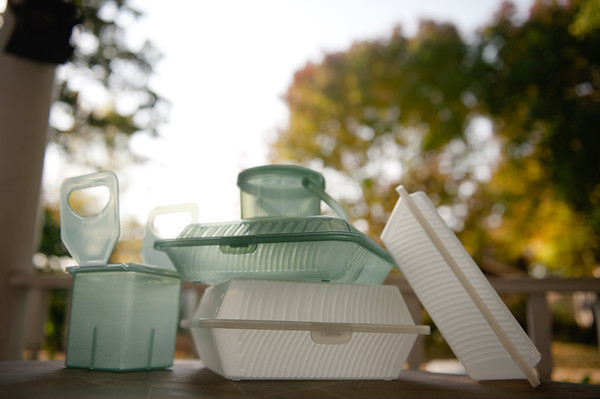
Here’s how it works: Consumers log onto nothro.com, sign up for a year of service ($20, unlimited containers), and download the company’s app onto their smartphone. The app lets them check out reusable containers from participating restaurants: a green screen means they can take a to-go container; a red screen means they have one to return. At the restaurant, they show the vendor their green screen and order their takeout. They also scan a QR code on a table tent that tells No Thro they have a container, simultaneously turning their app from green to red and charging the restaurant for the reusable container. Restaurants also pay a monthly service fee (still to be determined) to be a part of the program, which gives them an endless supply of clean to-go containers.
Clean is the operative word. The whole reason you can’t bring a bowl from home is that the department of health says to-go containers have to be professionally washed and sanitized. “In my dirty, hippy days I always tried it,” says Bailey, “but the theory is that if I say, ‘Hey man, I washed this at home, it’s fine,’ and I didn’t — then you put the beans in the container, the spoon gets contaminated and goes back in the restaurant’s bean dish and the plague goes everywhere.” So, No Thro members will have to return their reusable to-go containers to conveniently placed bins. Once they do, they’ll scan another QR code, and the database will tell Bailey there’s a container in the bin. Once the bin is full, he can swing by on his bike, pick up all of the containers, and take them to a professional kitchen for washing. The scan also gives the consumer a green light to pick up a new to-go container.
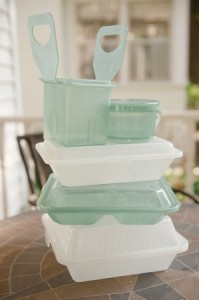
The phone app makes the whole transaction easy and, like the Netflix model, ensures the containers are returned. “It’s burdensome, and you wish you didn’t have to do it,” he says. “For this model to work, there has to be some way that you have to bring it back to use another one. It’s not that people are malicious thieves, they’re just busy. It’s what people do. I can’t afford to do it on the honor system.” It won’t help that the No Thro containers are super durable and nifty looking. The rice box is particularly darling — its handles look like big, plastic, robot rabbit ears — and it’s just the kind of handy container a person might covet for their yogurt container collection.
So will consumers sign up for the service and play by the rules? According to the Portland case study, the answer is a resounding yes. The city has a booming food truck scene, with more than 700 trucks licensed. Add to that an enthusiastic community of to-go diners that uses an estimated 60,000 to-go boxes a year. Go Box, founded and run by Laura Weiss, has been in business for two years. Go Box members pay $12 a year and get a token, which they can then exchange for a box at one of the 50 participating food trucks. After eating, diners return the box to a brick-and-mortar drop-off spot and get a new token. So far, 1,000 foodies have signed on — keeping an estimated 10,000 to go boxes out of Portland’s waste stream.
Perhaps because of Weiss’ success, Bailey isn’t so worried about getting consumers to subscribe to the service, but restaurants are proving a bigger challenge than initially envisioned. It’s a classic chicken-andeegg scenario. Restaurants won’t sign up without knowing there’s a consuming public there to use it; diners won’t sign up if there’re no restaurants to order from. “It’s not because the people don’t care,” he says. “It’s just that, one, it’s a goofy new thing and, two, it costs money, and a lot of restaurants operate at very tight profit margins. And we have a marvelously efficient way of dealing trash: You use something, you throw it away, it goes away, and it doesn’t cost you more money.”
Bailey hasn’t set a price for his reusable to-go containers, but he expects them to come in between $0.15 and $0.22 a piece. Not bad for a container with a life cycle of “thousands and thousands” of washings. At a restaurant supply, disposable plastic clamshells run about $0.20 a piece, while Styrofoam is much less expensive, around $.07. “There’s a lot of Styrofoam in Minneapolis, so that’s the challenge and the opportunity,” he says. “One of the things that’s working well in Portland is that a lot of the food trucks use clamshells. Here, they tend to use those checkered paper boats, and those are super, super cheap. I can’t compete with the paper boats for price.”
Bailey says that, if he were ruling the world, the restaurants that launch the program would all be located close together, preferably in downtown Minneapolis and St. Paul. “The skyways are the perfect place,” he says. “Not because I’m infatuated with skyways, but because you get repeat customers. This only works at a scale where people are coming back again, again and again, and where you have all disposables and a density of trash — all of which the skyway provides.” In theory, the skyways are a kind of enclosed system, where people might get their takeout lunch, consume it at the office, and then dispose of the reusable container at a conveniently located No Thro drop box as they pass through the skyway on their way home.
This idea seems to hold true at the University of Minnesota, to our knowledge the only local example of a reusable to-go container program. According to Marketing Manager Heather Dickson, the university is currently offering reusable to-go containers at three campus restaurants. Diners can purchase a $3.25 membership, which comes with a keychain tag and their first container. As long as they return the container, there are no additional fees. After two years, the program has around 200 participants, and Dickson says it is most popular at Bistro West, a restaurant in the Hubert H. Humphrey School of Public Affairs Building that serves primarily faculty and staff. To Bailey’s point, most of the folks eating at Bistro West are regulars, who get their food and take it back to an office in the Humphrey building. Although she hasn’t collected data on it, Dickson thinks the more transient student populations have been slower to adopt the program because they don’t like carrying the containers around in their backpacks and so are less likely to return them, which would make membership rather expensive.
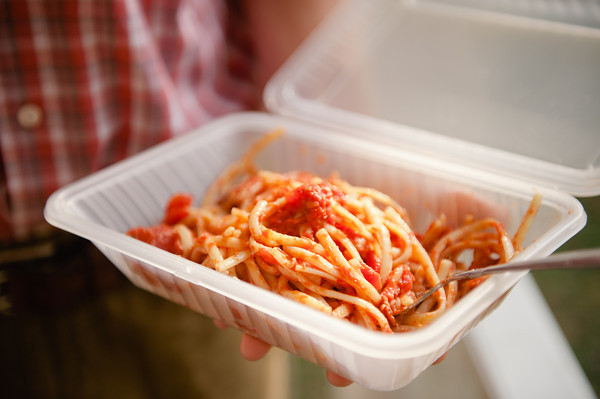
In addition to the skyway restaurants, Bailey is looking at mall food courts, Midtown Global Market, and co-ops with takeout delis and salad bars, as well as stand-alone restaurants with a solid takeout base, such as Brasa Premium Rotisserie. He hopes to launch in mid-November. “Everything is ready,” he saysn “I just need three restaurants to say yes. Like anything, it will be easier to sell this once it is a real, existing thing — ’cause right now it’s just John Bailey’s cool idea.”
If he seems a little nervous about those first, few pilot restaurants, Bailey is also prepared for his venture to grow like mad. The No Thro platform, developed by the team at Galactic Edge in St. Paul — who he met while co-officing at CoCo — was designed to grow exponentially. “If Chicago wanted to do it as well, it wouldn’t require more work,” he says. “I think there’s other cities that will want to do this, but again, I have to actually get a client before I start talking about Chicago, New York, and the world.”

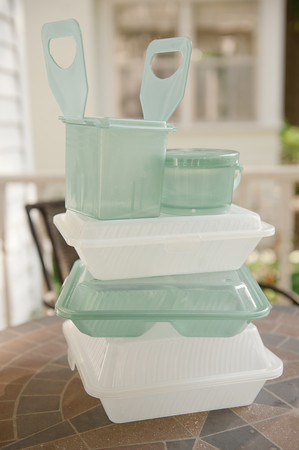
Great article, so excited to see John’s idea spreading to the public view! As CEO of Galactic Edge it has been a pleasure working with John so far, and we look forward to supporting the folks who adopt his program. Those first few restaurants are going to be the pioneers, the early adopters, and we are excited to see who steps up to the plate (pardon the pun) for reducing waste and launching a community of people who care :)
Thanks for writing this, and we look forward to everyone’s feedback and thoughts…
Phil Gapp
CEO for Galactic Edge Innovative
This is a really cool idea. I lived in Korea for a while, and all the delivery restaurants used reusable containers, which you then left outside your door and the delivery people returned later to pick up.
Has John figured out if there is a net energy savings from collecting, washing and reusing the containers vs. using once and discarding? Obviously better from a landfill perspective, but what about if the single-use plastic was being recycled (since Minneapolis and some other cities are now collecting more plastic than just bottles)?
This is John. Thank you for the question about net energy savings from reuse. I’ve worked closely with the Minnesota Pollution Control Agency (MPCA — sort of the MN’s EPA) as they have been working with other national agencies and NGO on heavily promoting resuse of consumer goods. As they would say, in the “hierarchy of solid waste” reuse wins out over disposables or recycling 99 out of 100 times. This is because it is the production of goods is where the overwhelming amount of resources are used compared to “end of cycle” resources such as transportation, washing, etc. So then, it is in the production of all those disposables where the majority of water and energy gets used and limiting that production makes up for the water and energy used in the washing.
Yikes, this is starting to sound like a lecture, which is not my intent. Recycling of plastic is a good thing to do, and as you note, it is becoming easier in Hennepin County. We should all do it, and I certainly do. However, the recycling of plastic is itself a highly industrial process. If you really want to go into the weeds on this, one good study recently done looks at reusing and washing water bottles vs recycling plastic bottles. Reusing comes out ahead by miles even considering the costs of making aluminum or steel bottles. You can check out here: http://www.deq.state.or.us/lq/sw/wasteprevention/drinkingwater.htm
Jason Hill is a local expert at the U who teaches a bunch of classes on resource economic and lifecycle analysis. He deals with this subject a lot. I haven’t taken his classes by many colleagues have: http://www.bbe.umn.edu/People/Hill/index.htm
Feel free to contact me directly with any further questions, john@nothro.com. Thanks!
Thanks, John! Excellent resources.
So sad….Seems that one needs a smartphone to participate, and I have a regular old cheapie cell. Some of us eco-conscious folks are also penny pinchers!
What if you order things that need to come in more than one container? Like, if I go to Brasa, I’m picking up family style and probably get a container of meat and a couple seperate ones of sides. The way this reads it’s a one-out at a time deal, so I couldn’t even pick up takeout for my boyfriend and myself on the way home unless he was with me with his own membership. The place that I would probably get the most use out of it is Surdyk’s cheese shop, and all the deli salads have different prices and get weighed out individually in their plastic tubs. It wouldn’t do me much good to get one of them in a returnable container.
I understand it would make it more difficult to count returns, of course. How do you know I really put all 4 containers in the bin when I scan in? But without multiples, I can’t imagine using it.
With multiples and you get it at Surdyk’s, I’m in. :)
LizaJae — That is just bad website writing on my part. This can easily be configured to allow for multiple containers to be used by one member. Whether you are given 1 or 4 or 10 containers with a purchase, my only concern is that you bring them back. I’ll make that clearer in the description.
The original theory was that this would be mostly used in heavily used lunchtime places, such as skyways, in which case food tends to come in a single container. But you are right, that other take out is not like that. Funny you mention Brasa, because I just got food from there last night and with 4 grown-ups and 4 kids it was quite the concoction of containers!
Suzanne — I would love to figure out a way to do this without smartphones, and I’m still looking into it.
If you cant determine your costs, how do you know what the energy inputs are for the program?
JohnnyU — I don’t follow.
Is anyone doing this type of program with glass or metal containers? I’m all for this type of program for the trash and energy reduction benefits but I’m also concerned about chemicals leaching into food from heated plastic containers.